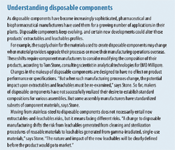The Means to Monitor Chemical Migration
Industry associations will soon provide new recommendations about extractables and leachables.
Good manufacturing practice and FDA regulations require pharmaceutical companies to know their production processes. Understanding the chemicals that potentially could migrate into final products is crucial, particularly for companies that incorporate single-use equipment within their facilities. Manufacturers need to identify which chemicals could migrate and quantify the likelihood of this migration. A forthcoming Parenteral Drug Association (PDA) technical report that recommends a risk-based approach, and pending safety and analytical thresholds from the Product Quality Research Institute (PQRI), will help drugmakers develop appropriate extractables-and-leachables strategies.
The PQRI document
In 2006, PQRI published recommendations to help drugmakers develop safety thresholds for extractables and leachables in orally inhaled and nasal drug products (OINDP). The group is currently at work on a companion document that will address extractables and leachables in parenteral and ophthalmic drug products (PODP). The new document will be submitted to the PQRI Steering Committee in 2012, according to Diane Paskiet, chair of PQRI's leachables and extractables PODP working group.

IMAGE: ANDERSEN ROSS, LAWRENCE LAWRY, GETTY MAGES. COMPOSITE: DAN WARD
The PQRI working group writing the document includes industry experts and representatives of the US Pharmacopeia, FDA, and HealthCanada. The group is divided into a chemistry team, which will discuss how to conduct extractables studies, and a toxicology team, which will provide advice about evaluating chemicals' safety.
PQRI will submit the final recommendations document to FDA. The document is intended to demonstrate best practices for the evaluation and qualification of leachables in parenteral and ophthalmic drug products. These practices have been extrapolated from the OINDP recommendations, and future documents could potentially address other dosage forms or routes of administration, says Paskiet.
The focus of the PODP document is to demonstrate how to conduct controlled extraction studies to understand the chemistry of the materials and incorporate justifiable safety thresholds. "Our recommendations are to start the selection process during development and begin to qualify components early, rather than in late phases of development, because if you have something objectionable, you can understand the potential to cause patient harm and eliminate or mitigate the risk," says Paskiet.
The new publication will present the safety thresholds and analytical-evaluation thresholds for leachables. The leachable's analytical-evaluation threshold is derived from the scientifically justified safety-concern threshold and defines the level above which scientists should begin to identify and assess leachables. The document also will offer advice about applying the thresholds, taking into consideration factors such as dose duration, patient population, and product-specific characteristics.

Understanding disposable components
As part of its preparation for drafting the document, PQRI performed extraction and analytical testing on various example materials. The group's results will form the basis for its recommendations for the best approaches for performing controlled extractions, including rationales for selecting various types of solvents and recommendations for appropriate analytical methodology in extractables and leachables testing. The document will offer examples to illustrate how PQRI applied its methods to materials commonly used in parenteral and ophthalmic drug products.
Drugmakers will also find advice about thresholds for known leachables in the final document. The document's authors will establish categories for known leachables based on safety concern levels, says Paskiet. Additional topics will consider the best demonstrated practices for studying secondary packages, such as labeling. The document will also help scientists determine whether simulation studies are appropriate after a material has been fully characterized, says Paskiet. The group currently is acquiring data about these subjects.
In some respects, parenteral and ophthalmic therapies call for an approach different from that for inhaled drugs, partly because more of the former products are aqueous-based, and partly because parenteral and ophthalmic drugs can be potent or used for short durations.
The PDA technical report
PDA recently formed a task force to write a technical report about single-use equipment, and part of the document will help the reader address extractables and leachables. The task force includes more than 20 people from biopharmaceutical companies, suppliers, consulting–engineering firms, and regulatory authorities, says Paul Priebe, director of fluid-management technologies at Sartorius Stedim Biotech North America and member of the PDA Single-Use Task Force. PDA plans to publish the report before the end of 2011.
The technical report is intended to be a comprehensive document to guide users in evaluating, qualifying, and implementing single-use systems. The report's main thrust will be the application of risk analysis as the basis for all activities involved in implementing disposable components, including assessing extractables and leachables. "The risk-based approach is not a novel concept, but the formal promotion of this approach in a consensus document should give end users the confidence to use it to implement single-use technologies in their own processes," according to Priebe.
"The goal is to offer a flexible approach to developing a well-designed strategy, so end users can customize their strategy based on their needs and capabilities, thereby developing a robust process that includes process and logistic controls supporting the desired states of patient safety and product availability," says Priebe. For a low-risk application, an end user could develop a strategy based on supplier documentation, but a high-risk application could require validation using process-specific parameters.
Because the document will promote a risk-based approach to qualification and implementation, the task force decided that proposing specific limits or analytical methods would be inappropriate. Instead, the report will refer readers to other documents for guidance, such as the Bio-Process Systems Alliance's guide to extractables and leachables, which readers could use to define their analytical strategy.
One part of controlling extractables and leachables is the careful qualification of equipment suppliers. The technical report will describe how end users can qualify suppliers of single-use systems and what responsibilities the end user should expect the supplier to fulfill. "One key approach championed in the document is developing a partnership with suppliers so that science- and risk-based discussions and decisions can be made effectively during supplier audits and evaluations of single-use system supply chains," says Priebe.
To ensure that it addresses PDA members' concerns about extractables, leachables, and single-use equipment, the task force is developing a tool for the PDA website that will help start a dialog. PDA members also will be able to raise these subjects with the task force during PDA's workshop on single-use systems in Bethesda, Maryland, on Jun. 22–23, 2011.

Pharmaceutical Tariffs Are Imminent: How Industry is Bracing for Impact
April 16th 2025On April 14, 2025, the Trump Administration launched a national security-driven investigation into pharmaceuticals, a move that will likely result in tariffs being placed on pharmaceutical drugs, ingredients, and other components that are imported from outside of the United States.